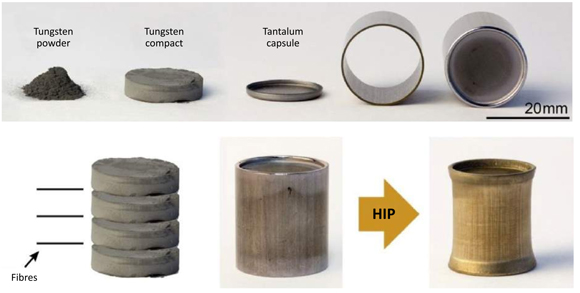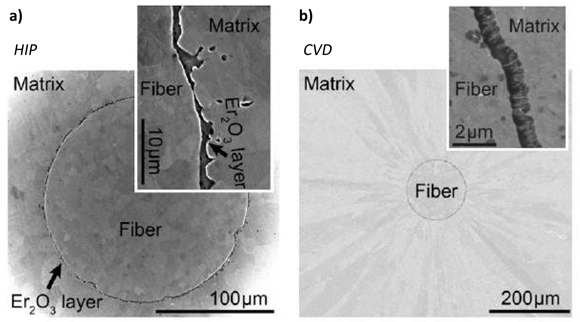Tungsten fibre-reinforced tungsten targeted for fusion reactors
January 2, 2018
Tungsten, which has the highest melting point of all elements, is considered the main candidate material for the first wall of the plasma vessel in fusion reactors. This is because of its reliable resistance to the harsh operating conditions in the long duty-cycles in these reactors caused by transient heat loading, thermal fatigue, neutron irradiation and erosion.
However, whilst tungsten meets the demands of high strength, plasma compatibility due to its low hydrogen retention, low erosion rates and acceptable activation under neutron radiation, the metal has low toughness when handled or operated below the ductile-to-brittle transition temperature. This is stated to range from 400-700K depending on the specific processing history of the material.
Bruno Jasper (Forschungszentrum Jülich GmbH) and research colleagues at the Max-Planck-Institut für Plasmaphysik and the Technical University München, reported in a paper presented at the 2017 Plansee Seminar held in Reutte, Austria, May 29-June 2, on research carried out within the framework of the EUROfusion Consortium, whereby the inherently brittle tungsten is reinforced with W-fibres to increase its toughness.
The Wf/W samples are processed by Hot Isostatic Pressing (HIPing), which was introduced as an alternative processing route for Wf/W composites to conventional chemical vapour deposition (CVD) technology since HIP enables the manufacturing of large-sized parts in short processing times.

Fig. 1 Processing steps of single-fibre Wf/W composites using hot isostatic pressing (From paper by B Jasper, et al., as published in the Proceedings of the 19th Plansee Seminar)
The authors stated that tungsten fibre-reinforced tungsten (Wf/W) enables extrinsic toughening of inherently brittle tungsten materials by the introduction of energy dissipation mechanisms similar to ceramic matrix composites. These mechanisms, for example the pull-out of the fibres or crack deflection at the tailored fibre-matrix, lead to a reduction of stress peaks at crack tips and thus significantly improve the resistance of tungsten against crack propagation.
In their work on HIPing of Wf/W samples, the researchers used two W powders having a mean particle size of d50 = 8.7 µm and d50 = 8.8 µm respectively. The W powders were die compacted at 110 MPa and 185 MPa to produce tablets having a diameter of 19 mm and height in the range 4-5 mm, with green densities of approximately 51.5% and 58%.
Four pellets of the same green density were filled into a tantalum (Ta) capsule with a single tungsten fibre (wire) placed between adjacent tablets. The capsules were closed with a Ta lid and sealed by electron beam welding under vacuum.
The W fibres used had a diameter of 150 µm and were produced by hot drawing. The fibres were coated with an Er2O3 interface, using reactive magnetron sputtering with coating thickness adjusted to 1, 2 and 3 µm, and had been cut to 10 mm lengths.
The encapsulated materials were densified by Hot Isostatic Pressing (HIP) at a constant pressure of 200 MPa, while varying the sintering temperature between 1300-1900 °C. The dwell time of 4 hr at maximum temperature was kept constant in all HIP runs.
The authors reported that temperatures in the range of 1500-1600°C were found to be required to achieve densities higher than 98% of the theoretical density at a pressure of 200 MPa.

Fig. 2 Microstructure of Wf/W composites with a 1 µm thick Er2O3 interlayer produced by (a) hot isostatic pressing, (HIP at 1600 °C, 200 MPa, 3 h) and (b) Chemical vapour deposition, CVD (From paper by B Jasper, et al., as published in the Proceedings of the 19th Plansee Seminar)
Higher temperatures would slightly improve the densification but lead to unacceptably high grain growth of the fibre and matrix, which decreases the mechanical strength of the Wf/W composite. A maximum density of 99.5% TD was reportedly achieved at 1700°C. Fig. 1 shows the processing stages of Wf/W samples by HIPing.
Tests were carried out to compare the HIPed Wf/W samples with Wf/W samples prepared by established CVD technology. Analysis of the matrix showed a dense W bulk, a deformed fibre and a deformed but still intact interface layer (Fig. 2).
Special emphasis was placed on push-out tests of single-fibre HIP samples, where a load is applied via a small indenter on the fibre, to test the debonding and frictional properties of the Er2O3 interface region enabling the energy dissipation mechanisms.
The authors reported that, while the fibre push-out of the CVD samples behaves as predicted in the shear-lag model, the HIPed Wf/W samples showed a superposition of effects, which they stated impede sound conclusions regarding interface parameters of the system.
To clarify the pronounced differences between the push-out behaviour of HIPed and CVD samples, a deeper investigation of the fibre matrix-interface region and its evolution will be required. However, irrespective of this result, their study provides optimised HIP processing parameters enabling the manufacturing of larger sized Wf/W composite parts to further qualify this material for the desired application.
The above article was originally published in PM Review magazine, Winter 2017, from the paper published in the Proceedings of the 19th Plansee Seminar, International Conference on Refractory Metals and Hard Materials, May 29-June 2, 2017.















